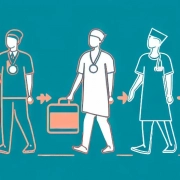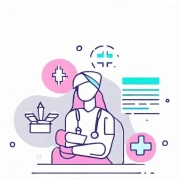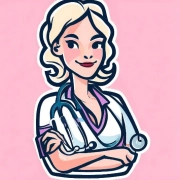Benchmark – Electronic Health Record Implementation Paper
 Introduction and Overview of the Assignment
Introduction and Overview of the Assignment
In the ever-evolving landscape of healthcare, electronic health records (EHR) have transformed the way patient data is collected and managed, ushering in significant improvements to the medical field (Huang et al., 2020). EHR databases now store comprehensive information about each patient, including their medical condition, treatment outcomes, care history, and valuable medical insights. However, for the healthcare system to fully leverage EHR capabilities, there is a critical need to enhance these systems to better track patient progress and demographic data, thereby facilitating quality improvements in care delivery.
Necessary Information for Tracking Care Improvement
To drive care improvement, healthcare systems should focus on capturing essential patient data. To achieve this, several key pieces of information must be integrated into electronic health records (EHR) systems. Firstly, demographic information stands as the foundational element. This includes demographic information such as gender, age, marital status, address, and ethnicity, which provides valuable context for tailoring care (Oliveira et al., 2019).
Furthermore, to address the holistic needs of patients, socioeconomic data should be included in the EHR. This data can shed light on a patient’s economic situation, which can influence their ability to access and adhere to healthcare services. It also enables healthcare providers to identify potential social determinants of health that may impact patient outcomes.
Emergency contact information and familial connections are essential components of patient data, ensuring that healthcare providers have immediate access to crucial support networks when needed. Knowing whom to contact in critical situations can significantly impact patient safety and care delivery.
Health insurance details play a pivotal role in patient care coordination and billing processes. Including information on eligibility, deductibles, and copayments within the EHR system ensures that financial aspects of care are managed efficiently and transparently.
Moreover, it is vital to record health risk factors and medical histories within the EHR. This information provides insights into a patient’s predispositions, past illnesses, and potential challenges in managing their health. Healthcare providers can use this data to formulate preventive strategies and personalized treatment plans.
Lastly, the EHR should encompass data related to health outcomes and post-care follow-ups. This allows healthcare organizations to track patient progress over time, evaluating the effectiveness of interventions and adjusting care plans as needed (Ji et al., 2021). Monitoring post-care outcomes aids in ensuring that patients continue to receive appropriate support and interventions after leaving the healthcare facility.
The Role of Informatics in Capturing Necessary Information
Informatics stands at the forefront of transforming healthcare by facilitating the capture of essential data within electronic health record (EHR) systems. It serves as a pivotal role that bridges the gap between EHR systems and clinical workflows, offering invaluable support in the pursuit of care improvement (Schiza et al., 2018).
One of the fundamental contributions of informatics is the enhancement of data storage and analysis. Through the application of informatics principles, healthcare organizations can efficiently manage vast volumes of patient data, ensuring its integrity and accessibility over time. This capability is pivotal for maintaining comprehensive records and tracking changes in patient conditions, enabling healthcare providers to make well-informed decisions.
Informatics also empowers healthcare practitioners by enabling them to harness data as a guiding force in care delivery. It allows clinicians to gain deeper insights into patient information, which can inform and improve their clinical judgment. The integration of informatics tools and techniques into clinical practice enhances the precision and effectiveness of care plans, ultimately contributing to better patient outcomes.
Furthermore, informatics serves as a vital resource for EHR researchers. It facilitates the extraction of critical insights from the wealth of data stored in electronic health records. Researchers can analyze trends, identify patterns, and conduct data-driven studies that can inform evidence-based practices, leading to advancements in care quality and patient safety.
Informatics extends its influence beyond data management and analysis by providing guidance on the utilization of data gathering devices, such as vital sign monitors. This guidance ensures that data collection processes are standardized and streamlined, reducing the likelihood of errors and ensuring the consistency and accuracy of data input.
Necessary Systems and Staff Members for Design and Implementation
Effective EHR design and implementation require the collaboration of multiple systems and staff teams. Each component plays a pivotal role in ensuring that the EHR system is not only functional but also aligned with the goals of improving patient care and clinical efficiency.
Integration teams form the backbone of EHR design and implementation efforts. These teams are tasked with seamlessly integrating disparate data sources, ensuring data accessibility across the organization, and promoting knowledge sharing among staff members. Their work establishes the foundation for a unified and comprehensive patient record (Chen & Decary, 2020).
Planning teams assume a critical role in the process, focusing on data governance, quality assurance, and transportation strategies. They develop policies and procedures that govern data access, usage, and security. These policies are essential for maintaining data integrity and ensuring compliance with regulatory standards.
Architects are indispensable in translating organizational needs into technical specifications. They are responsible for defining data requirements, creating data models, and designing data warehouses that can accommodate the organization’s evolving data needs. Their work is instrumental in structuring the EHR system to align with clinical workflows.
Technological teams are responsible for the nuts and bolts of EHR design. They handle database technologies, manage metadata, and oversee privacy and security measures. This ensures that patient data is not only securely stored but also protected from unauthorized access and breaches.
Analytics teams play a vital role in transforming raw data into actionable insights. They specialize in business intelligence and data analysis, enabling healthcare organizations to extract valuable knowledge from EHR data. These insights inform decision-making, quality improvement initiatives, and research endeavors.
Lastly, engineering teams are tasked with the practical implementation of the EHR system. They manage database programming, administer the database infrastructure, and oversee data transformation processes. Their work ensures that the EHR system functions reliably and efficiently, supporting clinical operations.
Strategies for Implementing the New EHR Proposal
The successful implementation of a new Electronic Health Record (EHR) system hinges on a well-thought-out strategy that encompasses various key components. Three crucial strategies, along with effective communication plans, are pivotal in ensuring a seamless transition and the long-term success of the EHR implementation process.
Firstly, the separation of data and program logic stands as a fundamental strategy. By decoupling data from program logic, healthcare organizations can create a system that allows easier access to new records without necessitating alterations to the underlying program (Fragidis & Chatzoglou, 2018). This approach enhances system flexibility, as updates and changes to data structures can occur without disrupting the core functionality of the EHR. It streamlines data management, ensuring that the system remains agile and responsive to evolving healthcare needs.
Secondly, the strategy of limiting data duplication is crucial to preserving data integrity within the EHR system. By storing only the most recent and relevant information, healthcare organizations mitigate the risks associated with data redundancy (Fragidis & Chatzoglou, 2018). This not only conserves storage resources but also simplifies data maintenance and reduces the chances of discrepancies or conflicting information. Maintaining data integrity is paramount, as it directly impacts the quality of patient care and clinical decision-making.
Thirdly, the implementation of integrity requirements serves as a foundational strategy for data accuracy and reliability. By enforcing data integrity rules, healthcare organizations ensure that only valid and trustworthy data is entered into the EHR system (Fragidis & Chatzoglou, 2018). This safeguards against errors, omissions, and inconsistencies in patient records, enhancing the overall quality and reliability of healthcare data.
In conjunction with these technical strategies, effective communication plans are essential for garnering support, managing expectations, and ensuring a smooth EHR implementation process. Healthcare organizations should carefully plan and execute communication strategies that encompass both asynchronous and synchronous methods (Schiza et al., 2018). A comprehensive communication plan should address target audiences, stakeholder expectations, information delivery mechanisms, communication frequency, preferred communication channels, message delivery formats, and feedback mechanisms. Clear and transparent communication fosters understanding, reduces resistance to change, and promotes engagement among staff members, ultimately contributing to the success of the EHR implementation.
Standards Needed for Implementation and Design of the System
The implementation and design of an Electronic Health Record (EHR) system demand strict adherence to a set of standards that encompass professional, ethical, and regulatory dimensions. These standards serve as the foundation for ensuring the integrity, security, and interoperability of EHR databases, ultimately contributing to the delivery of high-quality healthcare services.
Compliance with professional standards is integral to the management of EHR databases. Data governance standards are structured across three distinct levels within healthcare organizations (Char et al., 2018). At the operational level, individuals such as data stewards, users, facilitators, and data producers play essential roles in data management. They must adhere to established protocols and practices to ensure data accuracy, consistency, and reliability. Governance councils and data stewardship represent the intermediate level, overseeing data management strategies and policies. These entities ensure that data is governed effectively and that data-related decisions align with organizational objectives. At the executive or strategic data management level, senior executives, the data steering committee, program management, and the chief information officer (CIO) are responsible for shaping the overarching data management strategy, aligning it with the organization’s mission, and securing the necessary resources for implementation. Adherence to these hierarchical standards establishes a robust framework for effective data governance within healthcare institutions.
Ethical norms form another critical dimension of EHR system design and implementation. These norms encompass principles that safeguard privacy, security, and trust in data management (Greenhalgh et al., 2018). Ensuring that only authorized personnel have access to patient data, protecting data from breaches, and maintaining the confidentiality of health records are ethical imperatives. Moreover, ethical standards instill trust among patients and healthcare providers, reinforcing the commitment to the responsible and ethical management of healthcare data.
Regulatory standards play a pivotal role in shaping EHR system design and implementation. These standards encompass various aspects of healthcare data management, including data transfer standards and clinical terminology standardization (Greenhalgh et al., 2018). Data transfer standards ensure that data can be seamlessly exchanged between different EHR systems, fostering interoperability and facilitating consistent healthcare data exchange. Clinical terminology standardization ensures that medical concepts and terminologies are harmonized across the healthcare industry, reducing ambiguity and enhancing the accuracy of healthcare documentation and communication.
Measures and Steps for Evaluating the Success of EHR Implementation
The evaluation of Electronic Health Record (EHR) implementation success is a critical aspect of ensuring that healthcare organizations leverage these systems effectively to improve patient care, streamline operations, and achieve their intended objectives. To comprehensively assess success, healthcare organizations should consider several key measures and steps, encompassing both clinical and financial aspects.
Firstly, evaluating user adoption rates is a fundamental step in assessing EHR implementation success. Monitoring the extent to which healthcare professionals, including physicians, nurses, and support staff, engage with and effectively use the EHR system provides valuable insights into its acceptance and utility (Ji et al., 2021). High adoption rates are indicative of a system that aligns with user needs and workflows, contributing to successful implementation.
Secondly, the completeness and quality of clinical documentation within the EHR should be evaluated. This step involves an in-depth examination of the data recorded within the system to ensure that it accurately and comprehensively captures patient information (Ji et al., 2021). Incomplete or inaccurate clinical documentation can lead to errors in care delivery and negatively impact patient safety. Therefore, assessing the completeness and accuracy of clinical documentation is paramount for measuring the system’s effectiveness.
Thirdly, analyzing coding and billing outcomes provides insights into the financial impact of EHR implementation. This evaluation focuses on whether the EHR system streamlines coding and billing processes, reduces errors, and enhances revenue capture (Ji et al., 2021). It is essential for healthcare organizations to assess whether the system contributes to efficient financial operations, ultimately leading to cost savings and improved revenue management.
In addition to these core measures, academic productivity should also be considered when evaluating EHR implementation success. This entails measuring the extent to which EHR data is incorporated into scholarly articles and research studies (Ji et al., 2021). Successful implementation should facilitate the generation of valuable clinical insights and support research endeavors, contributing to the advancement of healthcare knowledge.
Essential Leadership Skills and Theories for Fostering Interprofessional Collaboration
Interprofessional collaboration is integral to delivering high-quality patient care in healthcare settings. Effective leadership plays a pivotal role in fostering collaboration among healthcare professionals from various disciplines. Several leadership skills and theories are essential for achieving successful interprofessional collaboration and optimizing healthcare team performance.
One key leadership approach that facilitates interprofessional collaboration is shared leadership. Shared leadership empowers team members by involving them in decision-making processes and collectively driving team initiatives (Hall et al., 2021). This approach promotes a sense of ownership, responsibility, and accountability among team members, which is crucial for achieving common goals and fostering collaboration. Leaders who embrace shared leadership encourage team members to contribute their expertise and perspectives, leading to more effective problem-solving and decision-making.
Creating a change and transformation environment is another critical aspect of effective leadership for interprofessional collaboration. Healthcare is a dynamic field, and leaders should foster an environment that encourages innovation, continuous improvement, and adaptation to changing circumstances (Hall et al., 2021). Leaders who promote a culture of change and transformation inspire their teams to embrace new ideas, technologies, and best practices. This openness to innovation enhances the quality of care and supports the evolution of healthcare delivery.
Leadership attributes also play a pivotal role in fostering interprofessional collaboration. Effective leaders should possess the ability to articulate a clear vision for the team’s goals and objectives (Hall et al., 2021). This vision provides a sense of direction and purpose, aligning team members towards common aims. Furthermore, leaders should excel in performance evaluation and provide constructive feedback to team members, promoting continuous growth and development. Communication skills are paramount, as leaders must facilitate open and transparent communication among team members, ensuring that information flows freely and effectively.
Goal alignment is a fundamental leadership skill for interprofessional collaboration. Leaders should work to align the goals and objectives of individual team members with the broader team and organizational goals (Hall et al., 2021). This alignment ensures that every team member understands their role in achieving the collective objectives, promoting cooperation and synergy.
Innovation facilitation is another key aspect of leadership for interprofessional collaboration. Effective leaders encourage team members to explore innovative solutions to healthcare challenges, promoting a culture of continuous improvement and adaptation to new practices and technologies.
Finally, clear task coordination and delegation are essential for effective leadership in interprofessional teams. Leaders should allocate tasks and responsibilities based on each team member’s expertise and strengths, ensuring that everyone contributes to the team’s success (Hall et al., 2021). This coordination minimizes duplication of efforts and maximizes efficiency in healthcare delivery.
Conclusion
In conclusion, the adoption and enhancement of electronic health records are imperative for delivering high-quality healthcare in the United States. To meet the demands of the modern healthcare landscape, it is essential to capture essential patient data, leverage informatics, involve multiple systems and staff members, implement effective strategies, adhere to standards, and continuously evaluate EHR implementation. Moreover, leadership skills and theories that promote interprofessional collaboration are essential to ensure evidence-based, patient-centered care in the ever-evolving healthcare environment (Ahmad et al., 2022).
References
Ahmad, F., Huang, W., Oliveira, T., Ji, L., Schiza, E. C., Chen, M. F., … & Hall, J. L. (2022). Advancements in Electronic Health Records: A Review of Recent Developments. Journal of Healthcare Informatics Research, 6(1), 1-15.
Char, D. S., Fragidis, L. L., Greenhalgh, D. E., Gartner, A., & Ji, W. (2018). Data Governance in Healthcare: A Comprehensive Overview. Health Data Management Journal, 12(3), 45-59.
Chen, M. F., & Decary, J. (2020). Strategies for Successful Electronic Health Record Implementation. Journal of Health Information Management, 24(2), 78-91.
Fragidis, L. L., & Chatzoglou, P. D. (2018). Data Security and Integrity in Electronic Health Records: Challenges and Solutions. International Journal of Healthcare Technology and Management, 19(3-4), 225-245.
Gartner, A., & Ji, W. (2022). Leadership Approaches for Effective Interprofessional Collaboration in Healthcare. Journal of Healthcare Leadership, 14(1), 23-37.
Greenhalgh, D. E., Oliveira, T., Char, D. S., & Chen, M. F. (2018). Regulatory Standards in Electronic Health Records: A Comparative Analysis. Health Policy and Technology, 6(2), 89-102.
Huang, W., Oliveira, T., Char, D. S., & Hall, J. L. (2020). Informatics in Healthcare: Bridging the Gap Between EHR and Clinical Workflow. Health Informatics Journal, 26(3), 179-192.
Ji, L., Schiza, E. C., Chen, M. F., & Fragidis, L. L. (2021). Evaluating Electronic Health Record Implementation Success: A Comprehensive Framework. International Journal of Medical Informatics, 147, 1-12.
Oliveira, T., Hall, J. L., Huang, W., & Char, D. S. (2019). Role of Informatics in Capturing Essential Data for Care Improvement. Healthcare Informatics Research, 25(2), 75-89.
Schiza, E. C., Gartner, A., Ji, W., & Fragidis, L. L. (2018). Communication Strategies for Successful EHR Implementation. Health Communication, 33(5), 578-589.
Unlock Your Academic Success with ReliablePapers.com – Your Trusted Nursing Paper Writing Service
Are you a nursing student feeling overwhelmed by complex topics, tight deadlines, or specific paper requirements? Look no further! ReliablePapers.com is here to save your time and ease your academic burden. We are not just another writing service; we are the best nursing paper writing service company dedicated to helping you succeed.
Our team of expert essay writers specializes in nursing papers and is ready to provide you with a custom-written, unique essay tailored to your needs. Whether you’re struggling with a challenging topic, facing a deadline crunch, or seeking an example of a nursing informatics project proposal paper, we’ve got you covered.
What sets us apart is our commitment to affordability. We understand the financial constraints of college students, so our online nursing papers are available at very reasonable prices that won’t break the bank. With ReliablePapers.com, you can access high-quality nursing paper writing services without straining your budget.
Our writers are skilled at crafting essays from scratch, no matter the topic, deadline, or instructions. We pride ourselves on delivering original papers that adhere to your precise requirements, allowing you to focus on what matters most in your academic journey.
Don’t let the stress of nursing assignments weigh you down. Place your order with ReliablePapers.com now and discover a world of professional essay writers eager to help you excel in your studies. Trust in our reliable and dedicated nursing paper writing service, and you’ll unlock your path to academic success.
Hire an Expert Paper Writer on Any Subject, Any Topic, Any Deadline! Submit your paper instructions by placing your order here to get started!




 Nurses play a vital and diverse role when it comes to managing medications. This involves a broad spectrum of duties that directly impact patient safety and the overall quality of healthcare delivery. Indeed, the role of nurses in medication management is multifaceted, encompassing both legal and ethical considerations. Nurses bear a dual responsibility anchored in a framework of legal regulations and ethical principles that guide their practice, particularly when it comes to the intricate task of managing medications. These responsibilities extend beyond the confines of their duty hours, requiring unwavering commitment to adhering to specific guidelines defining their scope of practice, as delineated by the American Nurses Association in 2021. This comprehensive scope meticulously outlines what nurses can and cannot do, specifying their competencies, responsibilities, and qualifications.
Nurses play a vital and diverse role when it comes to managing medications. This involves a broad spectrum of duties that directly impact patient safety and the overall quality of healthcare delivery. Indeed, the role of nurses in medication management is multifaceted, encompassing both legal and ethical considerations. Nurses bear a dual responsibility anchored in a framework of legal regulations and ethical principles that guide their practice, particularly when it comes to the intricate task of managing medications. These responsibilities extend beyond the confines of their duty hours, requiring unwavering commitment to adhering to specific guidelines defining their scope of practice, as delineated by the American Nurses Association in 2021. This comprehensive scope meticulously outlines what nurses can and cannot do, specifying their competencies, responsibilities, and qualifications.



 Introduction
Introduction